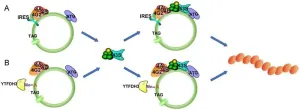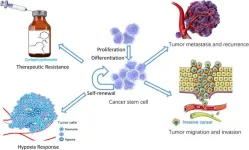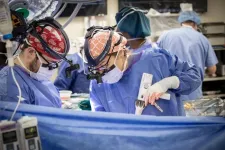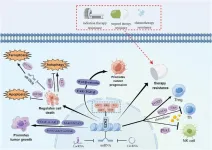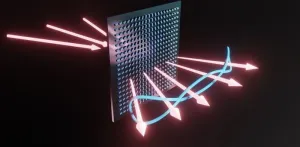(Press-News.org) An ambitious project led by Vanderbilt University Medical Center investigators aims to use artificial intelligence technologies to generate antibody therapies against any antigen target of interest.
VUMC has been awarded up to $30 million from the Advanced Research Projects Agency for Health (ARPA-H) to build a massive antibody-antigen atlas, develop AI-based algorithms to engineer antigen-specific antibodies, and apply the AI technology to identify and develop potential therapeutic antibodies.
ARPA-H is an agency within the U.S. Department of Health and Human Services that supports transformative high-risk, high-reward research to drive biomedical and health breakthroughs to benefit everyone.
“Over the last few decades, monoclonal antibodies have started playing an important therapeutic role in a wide range of disease settings, but we’re just scratching the surface. Monoclonal antibody discovery has the potential to impact a lot of different diseases where currently there are no therapeutics,” said Ivelin Georgiev, PhD, professor of Pathology, Microbiology and Immunology, director of the Vanderbilt Center for Computational Microbiology and Immunology, and the project principal investigator.
Traditional methods for antibody discovery are limited by inefficiency, high costs and fail rates, logistical hurdles, long turnaround times and limited scalability, Georgiev said.
“What we’re proposing to do is going to address all of these big bottlenecks with the traditional antibody discovery process and make it a more democratized process — where you can figure out what your antigen target is and have a good chance of generating a monoclonal antibody therapeutic against that target in a very effective and efficient way,” said Georgiev, who is also professor of Biomedical Informatics, Computer Science, and Chemical and Biomolecular Engineering.
Antibodies are part of our immune system. They are proteins produced by white blood cells (B cells) that bind to and inactivate antigens — targets on viruses, bacteria and even our own cells. Antibodies are effective as preventive and therapeutic treatments against viruses, cancers, autoimmune disorders and other diseases.
To identify a candidate therapeutic antibody, researchers generally screen and test thousands of antibodies against an antigen target, looking for the “needle in the haystack” that binds to and neutralizes the target. The traditional discovery process requires specific types of biological samples. For example, to find antibodies against an infectious disease pathogen, blood samples from people or animal models exposed to the pathogen are required. And then, if the pathogen mutates, a therapeutic antibody may become ineffective.
“With a computational approach, you’re no longer dependent on access to biological samples or multiple screening cycles,” Georgiev said. “You can simulate variants and generate antibodies ahead of time before the variants arise.”
Georgiev and his colleagues are engaged in three tasks as they work toward developing computational approaches for antibody discovery:
Generation of an antibody-antigen atlas of unprecedented size and variety
Development of AI-based algorithms for extracting information from the antibody-antigen atlas and engineering antigen-specific antibodies
Proof-of-concept studies to apply the AI technology to identify antibody candidates against antigen targets of biomedical interest
For the first task, the researchers are using a technology they developed called LIBRA seq (Linking B-cell Receptor to Antigen specificity through sequencing) that enables high-throughput mapping of antibody-antigen interactions for many antigens and B cells at the same time.
“For computational methods to work, we need to have a lot of data,” Georgiev said. “The scale of data that’s available for antibodies and antigens is lower than in other fields, which has been one of the limiting factors when it comes to developing AI approaches.
“If we train algorithms on the data that exists currently — much of it is for SARS-CoV-2, flu and HIV — the algorithms may be accurate for these targets, but they are less likely to be successful in extrapolating to a new target. We need to train them with a more diverse set of antigen targets, which is where LIBRA-seq comes into play.”
The investigators aim for the atlas to include hundreds of thousands — and potentially over 1 million — antibody-antigen pairs, compared to approximately 15,000 pairs currently available from published data, providing an unparalleled resource for researchers worldwide.
The team is already moving forward on the second task of building computational models, which they will improve as they populate the antibody-antigen atlas. For the third task, they will apply the AI technology to develop antibodies against cancer antigens and bacterial, viral and autoimmune targets. They will select one candidate antibody for preclinical development up to and including IND (investigational new drug) application.
“Our project will be providing a platform that can be used for a variety of different diseases, not just the specific targets we’re interested in,” Georgiev said. “Our team has spent many years trying to discover antibodies against a variety of indications, and it’s such an inefficient process with a lot of failure. If we can help change that, that’s going to be huge — not just for us, but for the entire field and for people with diseases where antibody therapies can make a difference.
“It’s going to be hard. It’s not an easy problem, but I think we have a good foundation for it, and we’ll do the best we can to make it work.”
Collaborators on the project are: Ben Ho Park, MD, PhD, Sarah Croessmann, PhD, Eric Skaar, PhD, MPH, Maria Hadjifrangiskou, PhD, and Jeremy Goettel, PhD, at VUMC; Tedd Ross, PhD, and Giuseppe Sautto, PhD, at Cleveland Clinic; and Maria del Pilar Quintana Varon, PhD, and Lars Hviid, PhD, at the University of Copenhagen. The Brock Family Center for Applied Innovation, a catalyst for advancing translational research to market, has engaged with and supported the Georgiev team.
Vanderbilt University and VUMC shared resources that are critical to the project are: VANTAGE (Vanderbilt Technologies for Advanced Genomics), ACCRE (Advanced Computing Center for Research and Education), and FCSR (Flow Cytometry Shared Resource). Wheeler Bio will participate in IND-enabling studies, cell lin
END
VUMC to develop AI technology for therapeutic antibody discovery
2025-03-07
ELSE PRESS RELEASES FROM THIS DATE:
Unlocking the hidden proteome: The role of coding circular RNA in cancer
2025-03-07
A new review article highlights the transformative role of circular RNA (circRNA) in cancer, revealing its potential as both a key player in tumor biology and a promising avenue for future therapies. Once thought to be noncoding RNA, circRNA has now been shown to encode functional proteins, challenging conventional RNA biology and opening up novel therapeutic possibilities.
Unlike traditional messenger RNA, circRNAs form a continuous loop, lacking the typical 5' cap and 3' tail. This unique structure was originally believed to preclude them from protein translation. However, recent discoveries demonstrate that specific internal ribosome entry sites (IRES) and N6-methyladenosine ...
Advancing lung cancer treatment: Understanding the differences between LUAD and LUSC
2025-03-07
Lung cancer remains one of the leading causes of cancer-related mortality, with lung adenocarcinoma (LUAD) and lung squamous cell carcinoma (LUSC) representing the most prevalent subtypes of non-small cell lung cancer (NSCLC). Despite their classification under the same umbrella, these two forms of lung cancer exhibit distinct genetic landscapes, therapeutic targets, and treatment responses.
Recent advancements in next-generation gene sequencing have identified key driver genes that differentiate LUAD and LUSC, influencing their respective clinical management approaches. LUAD is frequently associated ...
Study reveals widening heart disease disparities in the US
2025-03-07
A study published March 6 in The Lancet Regional Health — Americas highlights a growing divide in cardiovascular health in the U.S., showing that wealth and education play a significant role in heart disease risk.
The research, led by Salma Abdalla, MBBS, DrPH, an assistant professor of public health at Washington University in St. Louis, reveals that the top 20% of high-income, college-educated Americans have far lower rates of cardiovascular disease than the rest of the population — disparities ...
The role of ubiquitination in cancer stem cell regulation
2025-03-07
This review highlights the critical role of ubiquitination in governing the functionality of cancer stem cells (CSCs), shedding light on potential therapeutic targets for combating tumor progression, recurrence, and drug resistance. Published in Genes & Diseases, this article explores the intricate mechanisms through which the ubiquitin (Ub) system regulates key pathways essential for CSC maintenance and survival.
Ubiquitination, a fundamental post-translational modification, plays a pivotal role in protein stability, cellular signaling, and gene expression, particularly in the context of CSCs. Dysregulation ...
New insights into LSD1: a key regulator in disease pathogenesis
2025-03-07
A new review highlights the pivotal role of LSD1 (lysine-specific demethylase 1) in regulating critical cellular processes and its implications for human diseases. This article sheds light on how post-translational modifications (PTMs) influence LSD1 activity, impacting its function in gene regulation and disease progression.
LSD1 is a histone demethylase that plays a significant role in chromatin remodeling and gene expression by modifying histone H3 lysine residues. It interacts with various protein complexes, allowing it to serve as both a transcriptional activator and repressor. The intricate modifications ...
Vanderbilt lung transplant establishes new record
2025-03-07
Surgeons and teams with Vanderbilt Lung Transplant performed 99 lung transplants in 2024, the most ever in one year. Two of the procedures involved combined organ transplants.
For the second calendar year in a row, Vanderbilt Lung Transplant has the busiest program in the Southeast and leads the nation in innovation in organ preservation and regeneration.
The Vanderbilt Transplant Center is now home to the nation’s eighth largest lung transplant program by volume, and is among the best in long-term outcomes, demonstrating the ...
Revolutionizing cancer treatment: targeting EZH2 for a new era of precision medicine
2025-03-07
The critical role of EZH2, an essential epigenetic regulator, in cancer progression and treatment is underscored in this new review article published in Genes & Diseases. The study highlights the transformative potential of EZH2 inhibition, paving the way for a new generation of targeted therapies aimed at disrupting tumor growth and overcoming treatment resistance.
EZH2, a core component of the Polycomb Repressive Complex 2 (PRC2), plays a fundamental role in silencing tumor suppressor genes through histone methylation. Its overexpression has been ...
Metasurface technology offers a compact way to generate multiphoton entanglement
2025-03-07
Quantum information processing is a field that relies on the entanglement of multiple photons to process vast amounts of information. However, creating multiphoton entanglement is a challenging task. Traditional methods either use quantum nonlinear optical processes, which are inefficient for large numbers of photons, or linear beam-splitting and quantum interference, which require complex setups prone to issues like loss and crosstalk.
A team of researchers from Peking University, Southern University of Science and Technology, and the University of Science and Technology of China recently made ...
Effort seeks to increase cancer-gene testing in primary care
2025-03-07
Up to 10% of cancers are caused by genes that can be easily detected by commercially available tests. These include such common cancers as cancer of the breast, ovary, colon, stomach, uterus and pancreas.
“We don’t routinely screen for cancer susceptibility genes in primary-care settings because genetic testing is often considered too complicated and primary care doctors already have so many things they need to address,” noted lead author Dr. Elizabeth Swisher, a UW Medicine gynecological oncologist. "But it is an opportunity lost.”
In the JAMA Network Open study published ...
Acoustofluidics-based method facilitates intracellular nanoparticle delivery
2025-03-07
A recent study published in Engineering presents an innovative acoustofluidics-based approach for intracellular nanoparticle delivery. This method offers a new way to transport various functional nanomaterials into different cell types, potentially revolutionizing therapeutic applications and biophysical studies.
The efficient delivery of biomolecular cargos into cells is crucial for biomedical research, including gene therapies and drug delivery. However, traditional delivery methods such as endocytosis of nano-vectors, microinjection, and electroporation have limitations. They may require time-consuming processes, complex operations, or expensive equipment. ...

